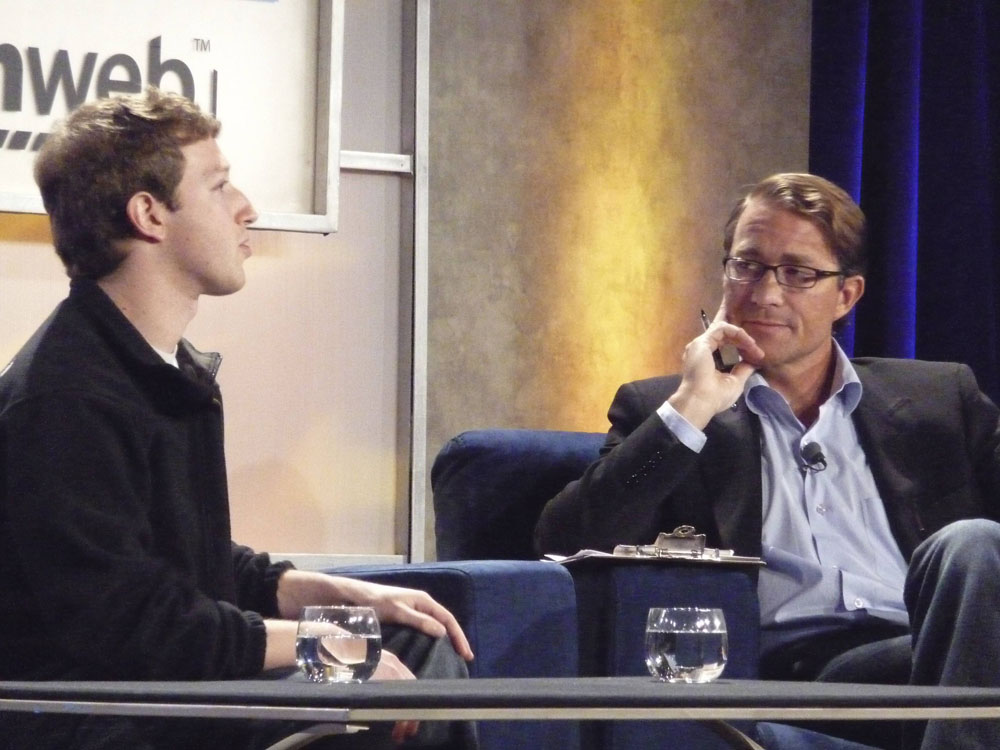
“Is Twitter a feature of Facebook?”
This was the question put to Mark Zuckerberg, Facebook CEO, by John Battelle during an onstage interview at O’Reilly’s Web 2.0 Summit last year.
This question seemed particular apt to me at the time. Though Battalle was asking the question partly in jest, in reference to rumors (which were later confirmed to be true) that Facebook was seeking to acquire Twitter, it nonetheless brought to the fore what I saw as the central problem with Twitter. Doesn’t Twitter simply replicate the status update feature already existent on Facebook, LinkedIn, and a myriad other social networking sites? Why would anyone want yet another status update, particularly one not linked to any established network? What is the point?
Zuckerberg didn’t have a good answer to this question at the time (though to be fair he was in ongoing discussions with Twitter, necessitating a certain level of diplomacy). I silently answered this question for myself in the affirmative.
A few weeks later I was astounded to learn that Facebook offered Twitter $500 million (mostly in Facebook stock) to acquire the company. Why would Facebook offer to buy something they already have? I was even more astounded to learn that Twitter turned them down! The global economy had already gone into a tailspin. Ancient and venerable companies were being dissolved like antacid tablets after a holiday feast. Unless you’re looking at a government stimulus package or the write downs on a mortgage bank’s balance sheet, half a billion dollars is still a lot of money (granted, it was in stock from a company that has yet issued an IPO; but still, that company is Facebook).
Especially when you’re a start-up.
Especially when you’re a start-up that not only hasn’t made any money but doesn’t have an obvious business model for doing so.
Especially when you’re a start-up whose service is already being offered in the market by more established companies.
Except that, it turns out, it isn’t.
What I failed to discern about Twitter is that it works very differently than other social networks. The basic concept of the status update, of course, is the same on all the major social networks. You type 140 characters or less into a text field and click “update.” The difference—and it is an important difference—lies in what happens next. On Facebook or LinkedIn (or any number of other social networks), your status update shows up in the feeds of people in your approved network (one’s “friends”). Your friends can then comment on the update. Typically, no one outside your social network will receive or have access to your status updates.
Twitter, however, diverges from this model in 3 important ways:
- Followers not friends. On Twitter, your status update is sent to your “followers” (an unfortunate term but only slightly more so than “friends”). Unlike friends on other social networks, followers are not people that you’ve approved (Twitter can be set to only allow approved followers, but that would defeat the whole point and almost no one does that). When you first start using Twitter, your followers are typically people you know personally—friends, colleagues, family members, etc. In this sense, Twitter at first functions very similarly to other social networks. But then a curious thing happens: other people—often complete strangers—become followers based on the content of your status updates.
- Content not relationships. You develop followers on Twitter in large part based on what you have to say. If your posts are interesting to other people, they will follow you. This is in large part subject-based. If I’m interested in a topic like health care reform, do-it-yourself biology, or the recent impact of massive object into Jupiter, I can search for those topics and find people posting about them. If I think some of those people have interesting things to say on those topics, I’ll likely follow them.
- Open not closed. On Twitter, status updates are visible to everyone. I can perform searches on Twitter (and even when I am not on Twitter, using a feed management platform such as Tweetdeck) that will query the entire Twitter network. This means that anyone using Twitter might read your post. (In fact, people not even on Twitter might read your posts. If one wants to view my Twitter posts, for example, they can all be found on my open profile page. There is no need to even have a Twitter account to view them.) Moreover, retweeting (reposting) other people’s messages is a common practice on Twitter. Your followers might repost your message to their followers, and so on. Additionally, the use of hash tags to indicate content is related to a particular topic or event can result in further dissemination of one’s posts. Using these mechanisms, posts on Twitter can circulate in surprising ways.
The impact of these three aspects of Twitter’s platform can be quite startling. There may be 250 million people on Facebook, but most people’s personal networks contain at most a few hundred. On Twitter, your posts may get read by any one of over 40 million registered users. For any given user, Facebook effectively consists of less than 500 people. On Twitter, everyone’s potential network exceeds 40 million.
This is not to say that Twitter’s model is better than that of Facebook, LinkedIn, Nature Networks, or other online networks. There are very good reasons why you might prefer a closed network for some forms of communication (and all of these networks offer open “groups” and other mechanisms which expand networks to some extent). For other forms of communication, however, a network that is open and content-centric has advantages. This is particularly true, for example, for scholarly and scientific communications.

- Image via Wikipedia
One of the best articles on the effects of social and professional networks on information diffusion was written long before the birth of the Internet. In 1973, a John Hopkins sociologist, Mark Granovetter, published a paper called “The Strength of Weak Ties” in the American Journal of Sociology. In this classic paper, Granovetter argues that innovation often travels most effectively via weak connections. You are likely to already be familiar with the work and ideas of your immediate colleagues and friends, for example. But a colleague that you communicate with only occasionally—say at an annual conference—is more likely to be a source of novel information. Moreover, that distant colleague is going to be more effective at spreading your novel ideas because your close colleagues and friends likely know many of the same people as you do, whereas the distant colleague likely has a very different group of people in his/her professional and social networks.
The structure of Twitter’s open, content-centric network enables information diffusion via weak ties. The platform has become a powerful tool for communicating scientific research, scholarship, and innovative ideas beyond one’s immediate peer group.
Of course, 140 character posts are not a substitute for other forms of formal and informal communication. But they augment such communication channels, increasing their impact and reach in ways other networks cannot.
Editor’s Note: Facebook’s recent acquisition of FriendFeed (covered through parody in another post), is probably the result of Zuckerberg trying to acquire’s Twitter’s advantages, this time without acquiring Twitter itself.
Discussion
14 Thoughts on "The Strength of Weak Ties: Why Twitter Matters in Scholarly Communication"
LinkedIn has (self-interestedly) warned against so-called ‘froleagues’, points where personal and professional social networks intersect – essentially the caution is “don’t let your boss see that drunken photo of you on FaceBook”.
I agree with everything you say above about Twitter, but I wonder what your thoughts on usage patterns are. Currently these seem to lie at the very intersection LinkedIn suggests we all avoid. Indeed I am constantly astounded by the fact that ‘professional’ people I follow intersperse ‘professional’ (i.e. useful) tweets with more personal (i.e. useless,’what I just had for breakfast’-type) tweets.
Do you think this is just because an accepted twitterquette in which we all have separate private and personal accounts is yet to emerge – or is Twitter just ahead of the curve in revealing an inevitable merging of the personal and private online? Both of course have implications for how scholarly publishers position themselves in relation to readers and authors.
Yes, it does seem that there is a lot of cross-over from professional to personal on Twitter (and Facebook for that matter). I think both of the reasons you cite are correct.
Indeed, Twitterquette is still emerging. Some Twitterers manage to walk the line between professional and personal very well. Tony Hsieh, Zappos CEO, is probably the best example of this. But I think some of that is due to a misperception as to how Twitter works. I think a lot of people (and I was one of them) think of Twitter as “Facebook lite.”
As Twitter becomes perceived as a legitimate forum for professional communication, we’ll see more of a shift to separate personal and professional accounts or to using different networks entirely for personal vs professional communication.
A recent article addressed this question. Their advice?
The only way out is to police your wall, even if that’s awkward. Don’t be shy about deleting untoward graffiti, eliminating your name from tagged photos, or even asking friends to remove incriminating pics that weren’t meant for public consumption…Then again, you could migrate to MySpace. Nobody pays attention to anything written there.
Great explanation. It all makes sense but I haven’t seen others articulate it quite as well.
And I found this blog through a Tweet and then subscribed to the RSS feed. So Twitter can also connect people to media in which you can say more than is possible in 140 characters.
I’m not finding a lot of social science and humanities scholars on there, though. Unless they are interested in digital humanities. Maybe my search tactics are faulty, but I suspect there is also a perception problem wherein many researchers don’t see the point.
I, too, found this post through the twitterverse. I will now go retweet that post so more people see it; this post was a great explanation of twitter’s success, as well as the power of broad networking.
I think you’re 100% right when you express shock that Twitter hasn’t cashed in–really, that’s the best and most reliable method of monetizing a web service. You build it, wait until it’s popular and generates buzz, then you sell it off for an obscene amount of money to someone else. Getting the service to turn a profit is then someone else’s problem. This dates back to the dotcom days, and transactions like Mark Cuban selling broadcast.com to Yahoo! for $5.9 billion.
I have a feeling that the folks behind Twitter may regret not cashing in. Twitter may indeed be here to stay, but the path to profitability is not obvious. The most obvious parallel might be e-mail, which everyone uses as well, but no one seems to be profiting from. FriendFeed at least seems to have pulled the trigger, so good for them.
“The structure of Twitter’s open, content-centric network enables information diffusion via weak ties.”
Brilliant! I had never thought of it that way at all, but it’s spot on.
One other thing about logistics. Twitter also serves (for me) as a way to keep other statuses updated (Facebook, my blog, this blog, Plaxo, etc.) – so in a way it’s a degree of consolidation for me.
Great post, Michael. (I’m so glad you’re here!)
![Reblog this post [with Zemanta]](http://img.zemanta.com/reblog_e.png?x-id=285a5b3f-f072-4a8a-8f54-1073716f6d32)


